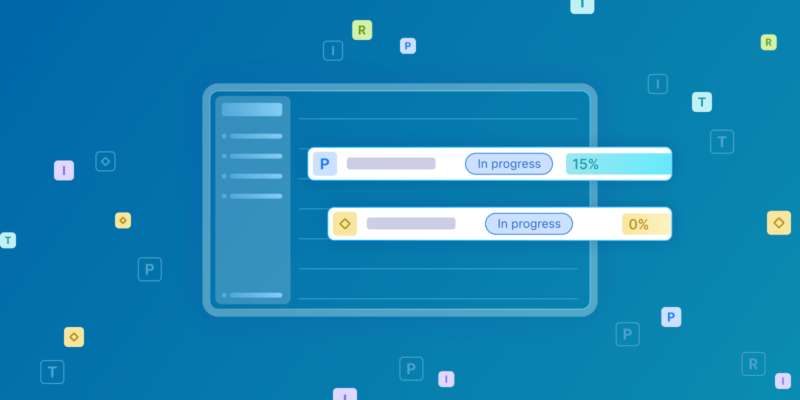Saving time and money during project planning and execution is akin to eating when hungry; you must do something to grow and survive. If you are unfamiliar with how project controls are vital concerning the use of cloud-based project management software (PM software), fear not: we are here to help you wrap your head around it.
What are Project Controls
Project controls involve collecting, managing, and analyzing data to foresee and positively impact a project’s cost and timing. This information is presented in ways that enhance decision-making and effective project management.
But what does that mean in simple terms beyond the vagueness of words like “management” and “analytical processes”? Thanks, PMBOK. We appreciate everything you do for us, but we need more clarification and some examples...
To begin with a simple explanation (we will get into the details soon), project controls are the tools that help you save time and stay on schedule during your project planning and execution, cutting costs. They vary in terms of specific project requirements. Still, these tools are the essentials of cloud project management software, which is widely understood as a necessity for boosting the following performance factors for many companies like yours.
So, let us now discuss the value of project controls and how they can save you time and money.
Main Components of Project Controls
Project management and control cover all aspects from project definition to planning, execution, and completion, supporting the entire lifecycle of your project. As previously mentioned, the use of controls may vary based on individual project needs. However, project controls systematically address, organize, and manage the following aspects of your project management system:
- Developing Your Project Strategy: Define methods to enhance future project control software use and improve project outcomes.
- Software Development, Updates, and Maintenance: Schedule and manage updates and maintenance for the project management (PM) software.
- Cost Estimation and Controls: Estimate project costs, manage expenses, control costs, and assess the project value.
- Risk Management involves managing, assessing, and analyzing project risks, cataloging past risks, and developing strategies to avoid future risks.
- Earned Schedule and Value Management: Implement earned and earned value management, including professional services work and organizational breakdown structures.
- Material Quality Oversight: Oversee and assess the quality of supplied materials.
- Comprehensive Integration: Integrate control elements with other project management domains holistically.
The Importance of Project Controls
Now that you know the scope of project controls for your Project management Software, let‘s discuss why these controls are essential. Chaos, disorganization, and bedlam are the opposite of control and are anathema to successful project management.
Effective project execution starts with detailed planning. Project controls are crucial in this phase.
You need robust project controls that align with your scheduling techniques to execute your projects properly. A tailored project control system is vital to fully leveraging your Project Management Platform and ensuring everything runs smoothly.
Project management has been evolving since the mid-20th century. History shows that projects without proper planning and careful monitoring will likely fail. This is why Project Management Software has been developed with integrated project control tools designed to correct and prevent scheduling errors.
Did you know project controls can save time and enhance financial outcomes?
According to a 2000 study by Independent Project Analysis, effective project control practices can decrease schedule overruns by 15% and enhance the net project value (NPV) by ensuring better resource scheduling. Additionally, when implemented correctly, project controls can reduce project costs by up to 10%.
Consider project controls as your indispensable assistant in project management. They guide and support your efforts, tailored to your project’s unique scope and scale. Now, let‘s explore how you can establish these controls effectively.
Key Strategies for Project Controls
Adequate project controls are crucial for ensuring a project’s success and should be established early in the project’s lifecycle. Both monitoring and controlling are continuous processes that should be integrated at every stage. Here are essential strategies to ensure adequate project controls:
Scope Definition: Clearly define the project’s scope. Through thorough communication, ensure that every team member understands all aspects of the project.
Team Organization and Task Assignment: Evaluate and assign the right tasks to the most suitable team members. Plan the team structure thoughtfully and establish methods to track their progress.
Risk Assessment: Identify potential risks early and discern which are manageable and which could derail the project. Develop a comprehensive risk management strategy to address these risks proactively, thus minimizing potential setbacks.
Status Monitoring: Establish a routine for regularly checking the project‘s progress. This could be through direct meetings or written reports. If the project advances faster than planned, identify what drives this progress and consider applying these successful elements to future projects. Conversely, understand what delays are causing to prevent similar issues in the future.
Communication Strategy: Maintain open and transparent lines of communication with your team and external stakeholders, ensuring transparency throughout the project.
Budgeting and Deadline Management: Create a detailed budget and track any changes rigorously, communicating regularly with the financial team. Set realistic deadlines and develop contingency plans for potential delays to mitigate the impact.
Performance Analysis: Implement a system to evaluate how each part of the project contributes to the overall objectives. Based on these insights, adjust resources or reallocate tasks as needed.
Continuous Evaluation and Adaptation: Regularly assess the effectiveness of project controls and adapt them as necessary to better meet project needs and address any emerging challenges.
By systematically applying these strategies, project managers can control the project lifecycle, ensuring that projects are delivered on time, within budget, and to the expected quality standards.
How to Implement Project Controls
Maybe not “awesome” (let‘s face it, this is crucial information, but perhaps not the sexiest topic), but adequately implementing project controls will vastly enhance how you manage your projects.
Project controls depend on accurate, high-quality data, a fixed schedule for progress reviews, and a realistic and practical baseline for effectiveness. When properly implemented, project controls incorporate the following features:
Use a Work Breakdown Structure (WBS) Project Controls.
WBS, the cost and schedule information coding system for your project management, is essential for managing adaptability/change and cost/schedule reporting. WBS links the reporting of both time and costs for your project. Consistent WBS coding defines the entire scope of the project and will be used for estimating and accurate project reporting.
Bring teams, clients, and stakeholders together.
This joint customer-delivery team tool is a crucial feature of project controls. It allows both parties to review the risk estimations, planned reporting processes, schedule, and cost estimates. Both parties are kept on the same page while discussing project planning and execution up to delivery. Customers understand the project scope, including resources, schedule, and budget.
Professional services project integration with project operations made easy.
No matter the industry, from construction and development to pharmaceutical and biotech research, Professional services projects can be integrated into project operations. However, interfacing between professional services projects can increase project framework complexity, risks, and costs and muddled project estimation ability.
However, effective integration is easily facilitated by using project controls that interface scheduling from each different integrated source. Using the WBS and other project control standards will effectively manage the interfaces, saving costs and reducing potential risks.
Project controls allow for client input.
The client often delivers commercial incentives and procurement strategies. Client input allows both parties to ally. When priorities are aligned between the client and project management, mutual agreement is ensured regarding how a project should be carried out, and if the client ever gets off-track, it can be corrected.
Incorporate risk analysis into the project controls.
Once risk analysis is incorporated into the project controls, it can provide a more significant, comprehensive, and organized analysis of project risks. Following project framework-wide risk analysis, contingencies will be implemented to secure more excellent project progress. Risk analysis is your most incredible time-saver and money-maker when risks can be seen for what they are: acceptable, manageable, or highly threatening.

Implement earned value analysis (EVA) to enhance your project control capabilities.
A well-planned, executed set of project controls allows for earned value analysis (EVA) to be used for progress monitoring, assessing the time and cost estimations and overall scope of the project, aiding in reducing cost overruns. EVA has an advantage over traditional tracking in that it uses the project’s resource costs and scope to predict future time and expense.
Planned values, the values of tasks that are in line with the project objectives, when compared with actual, recent past task values, allow customers and companies alike to have a coherent vision of what to expect from the tasks at hand.
EVA must be completed based on a baseline schedule agreed upon by both parties and estimates representative of the current project scope. Progress measurement is aligned with the customer.
Top-notch management at the project framework and project levels
Teams can quickly lose sight of the broader resource and project framework requirements, including whether the supply chain will satisfy these needs. This oversight can lead to chaos, especially when managing multiple projects simultaneously. By integrating the broader aspects of the company’s project framework into project controls, project delivery can achieve higher predictability and adherence to deadlines.
Project controls drive project value down the line
As long as reporting and data collection are not overemphasized and project controls include sufficient measures for management, project value will be at the forefront of each team member‘s mind. Ideally, the project controls process should balance upward and downward reporting.
How to Create Project Controls with Birdview PSA
Birdview PSA provides a comprehensive toolkit for setting up and maintaining project controls that help manage timelines, budgets, and overall project quality.
Start by clearly defining your project objectives and scope. Specify your goals, identify deliverables, and outline the key milestones.
Use Birdview PSA to create a detailed Work Breakdown Structure (WBS). This involves breaking down the project into smaller, manageable components or tasks.
With the project scope and tasks clearly defined, the next step is to schedule these tasks and allocate resources. Birdview PSA offers scheduling tools that integrate calendars and Gantt charts, visually representing the project timeline.

Assigning resources to specific tasks based on their skills and availability ensures efficient utilization of manpower, materials, and equipment.
Establish budget controls within Birdview PSA to monitor and manage project finances–input initial budget estimates for different project phases and tasks.
Utilize Birdview PSA‘s dashboards and reporting tools to monitor project progress continuously.

Leverage Birdview PSA‘s communication tools to inform all stakeholders about the project‘s progress, potential issues, and changes.
Set up automated notifications, emails, and project updates through the platform, fostering transparency and collaboration across the project team.
By following these steps to implement project controls with Birdview PSA, project managers can ensure that their projects are executed effectively and meet all designated timeframes, budget constraints, and quality requirements.
In closing...
We hope you take full advantage of Project Management Software by thoroughly incorporating project controls into your project management. While proper control is cost-dependent and time-intensive, the ROI you reap from detailed and adhered-to controls will improve your performance, and customers will notice.



